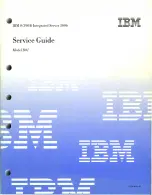
Breaking the 137GB Storage Barrier
A-4
Quickview 300
80/100/120/160/200/250/300GB PATA
A.1.5
What Else is Involved?
Effort is required from OS vendors to increase storage device addressing
up to 48 bits or more.
This increase will be a significant challenge for
many OS vendors that have 32-bit code models.
Adapting to 48-bit
commands will be easy, but most vendors will stop filling data at the 32-
bit boundary and pad the upper 16 bits with zeros, leaving that space
empty.
The BIOS companies will also have to perform some work to recognize
the increased capacity of the devices attached to the bus and allow the
extended 48-bit commands to pass on to the devices. Boot partitions will
also be an issue for the capacity of the drive if the BIOS does not
recognize the 48-bit addressing scheme at or before the system boots the
OS from the hard drive.
Independent software driver efforts for legacy operating systems
(Windows NT
4, Windows 98, and so on) will need to be implemented to
allow higher-capacity devices to work on installed systems and recognize
the maximum available capacity of the drive over the 137-gigabyte limit.
A.1.6
What is the Next Barrier?
While it is true that the ATA/ATAPI-6 standard defines a method to
provide a total capacity for a device of 144 petabytes, the next limit will
be imposed not by the ATA devices but by many of the popular operating
systems in use today. This limit will be at 2.2 terabytes (2,200
gigabytes). This barrier exists because many of today’s operating
systems are based on 32-bit addressing. These operating systems include
many flavors of Linux, Mac OS 9.x, and Windows 95, 98, ME, NT
4,
2000, and XP (Windows XP/64-bit also has the limit because of leveraged
32-bit code).
This barrier could be real as early as 2004 if current hard drive capacity
rate increases continue along the same growth trends.
Appendix A:
Terminology
•
BIOS
:
(an acronym for Basic Input/Output System design):
The BIOS processes and redirects all data as it is being
accessed and stored.
•
FAT
:
(an acronym for File Allocation Table):
The FAT tells the
computer where data has been stored on the hard drive.
•
CHS
:
(an acronym for Cylinders, Heads, and Sectors):
The
basic layout components of a hard drive. INT 13h & INT 13h
extensions: protocols used for accessing data on hard drives.











































